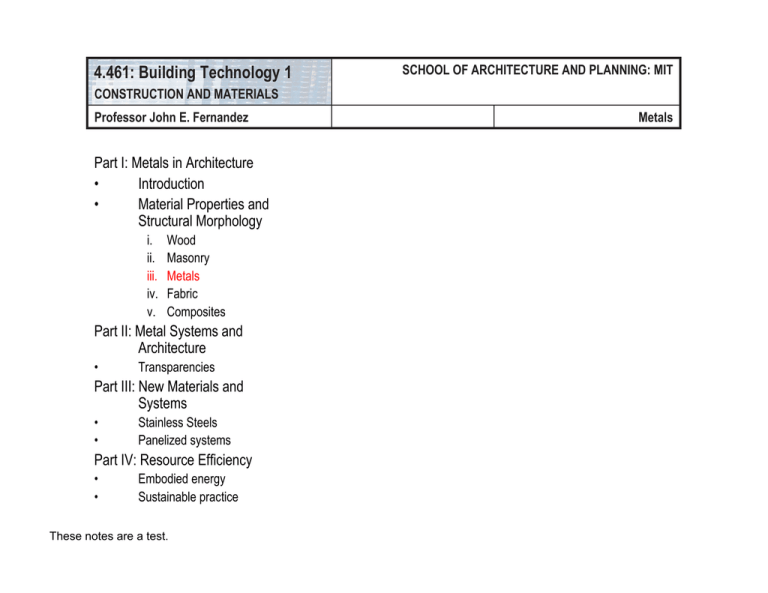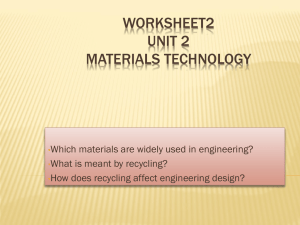4.461: Building Technology 1
advertisement

4.461: Building Technology 1 SCHOOL OF ARCHITECTURE AND PLANNING: MIT CONSTRUCTION AND MATERIALS Professor John E. Fernandez Part I: Metals in Architecture • Introduction • Material Properties and Structural Morphology i. ii. iii. iv. v. Wood Masonry Metals Fabric Composites Part II: Metal Systems and Architecture • Transparencies Part III: New Materials and Systems • • Stainless Steels Panelized systems Part IV: Resource Efficiency • • Embodied energy Sustainable practice These notes are a test. Metals Metals Part I: Metals in Architecture • Introduction • Structure and skin Metals Part I: Metals in Architecture • Introduction i. Historical trajectory Image by MIT OCW. Metals Part I: Metals in Architecture • Introduction: Steel Landmark developments i. Historical trajectory 1777-79 1780-1820 ~1800 1840 1846-50 1870s 1855 1870 1890 Currently First Cast iron bridge built in England Numerous cast bridges built, arch-shaped with main girders of individual cast iron pieces forming bars or truss Industrial production of rolled shapes begins in England Wrought iron begins to replace cast iron Brittania bridge over Menai Straits in Wales I-shapes rolled Development of the Bessemer process Introduction of basic liner in the Bessemer converter Steel permanently replaces wrought iron as principal building material Steels having yield stresses varying from 24,000 to 100,000 psi are readily available Metals Three types 1. Carbon steels 2. High-strength low-alloy steels 3. Alloy steels Heat-treated constructional alloy steels; A514 quenched and tempered alloy steel 100 Stress, kips per square inch Part I: Metals in Architecture • Material Properties and Applications of various steels Tensile strength, Fu 0.2% offset Minimum yield strength Fy = 100 ksi (C) 80 High-strength, low-alloy carbon steels, A572 (B) 60 Fy = 50 ksi Carbon steels; A36 40 (A) Fy = 36 ksi 20 0.05 0.10 0.15 0.20 Strain, inches per inch Image by MIT OCW. Typical stress-strain curves 0.25 0.30 0.35 Metals Carbon steels • • • • Carbon steels are divied into four categories depending on the percentage of carbon: Low carbon: less than 0.15% Mild carbon: 0.15-0.29 Medium carbon: 0.30-0.59% High carbon: 0.60-1.70% Structural carbon steels are in the mild category: A36 has max. carbon from 0.25-0.29%. Increased carbon percent raises the yield stress but reduces ductility and makes welding more difficult. Tensile strength, Fu 0.2% offset Heat-treated constructional alloy steels; A514 quenched and tempered alloy steel 100 Stress, kips per square inch Part I: Metals in Architecture • Material Properties and Applications of various steels Minimum yield strength Fy = 100 ksi (C) 80 High-strength, low-alloy carbon steels, A572 (B) 60 Fy = 50 ksi Carbon steels; A36 40 (A) Fy = 36 ksi 20 0.05 0.10 0.15 0.20 Strain, inches per inch Image by MIT OCW. 0.25 0.30 0.35 Metals High-strength low-alloy steels The addition to carbon steels of small amounts of alloy elements such as chromium, columbium, copper, manganese, molybdenum, nickel, phosphorous, vanadium, zirconium improves some of the mechanical properties. Additional strength is obtained through a fine-grained crystalline microstructure as opposed to the course graining of simple carbon steel. This type of steel yields at stresses from 40-70 ksi. Heat-treated constructional alloy steels; A514 quenched and tempered alloy steel 100 Stress, kips per square inch Part I: Metals in Architecture • Material Properties and Applications of various steels Tensile strength, Fu 0.2% offset Minimum yield strength Fy = 100 ksi (C) 80 High-strength, low-alloy carbon steels, A572 (B) 60 Fy = 50 ksi Carbon steels; A36 40 (A) Fy = 36 ksi 20 0.05 0.10 0.15 0.20 Strain, inches per inch Image by MIT OCW. 0.25 0.30 0.35 Metals Alloy steels Low-alloy steel may be quenched and tempered to obtain yield strengths of 80 – 110 ksi. Maximum carbon content of 0.20% to limit the hardness of any coarse-grain microstructure. The heat treatment consists of quenching [rapid cooling with water or oil from at least 1650 F to about 300-400 F], then tempering by reheating to at least 1150 F and allowing to cool. Tempering greatly improves toughness and ductility. Heat-treated constructional alloy steels; A514 quenched and tempered alloy steel 100 Stress, kips per square inch Part I: Metals in Architecture • Material Properties and Applications of various steels Tensile strength, Fu 0.2% offset Minimum yield strength Fy = 100 ksi (C) 80 High-strength, low-alloy carbon steels, A572 (B) 60 Fy = 50 ksi Carbon steels; A36 40 (A) Fy = 36 ksi 20 0.05 0.10 0.15 0.20 0.25 Strain, inches per inch Image by MIT OCW. 0.30 0.35 Metals Part I: Metals in Architecture • Material Properties and Applications of various steels A36 carbon General structural purposes, bolted and welded. Mostly for buildings. A53 carbon Welded and seamless pipe A500 carbon Cold-formed welded and seamless round, square, rectangular, or special shape structural tubing for bolted and welded general structural purposes. A501 carbon Hot-rolled welded and seamless round, square, rectangular, or special shape structural tubing for bolted and welded general structural purposes. A514 alloy Plates in thickness of 6 in. and under, primarily for welded bridges. A588 High S., Low A. Structural shapes, plates and bars for welded buildings and bridges where weight savings or added durability are needed; atmospheric corrosion resistance is about four times that of A36 steel. A913 High S., Low A. Structural shapes for bolted and welded construction. Metals Self-weathering steels have been widely adopted for conditions in which the surface of the steel is exposed to the weather. These steels are typically A588 for buildings and A709 for bridges. Several rules are important to note: 1. For optimum performance in the unpainted condition, the structure should be boldly exposed to the weather. 2. The development of the protective oxide film is best achieved under normal exposure, wherein the surfaces are wet at night by dew formation and dry during daylight hours. 3. Because this wet-dry cycle cannot occur when the steel, regardless of its grade, is buried in the soil or immersed in water, the protective oxide will not form and the performance will resemble that of mild steel carbon exposed to the same conditions. 10 Calculated average reduction in thickness, mils Part I: Metals in Architecture • Material Properties and Applications of various steels Corrosion 9 al tur c u Str 8 n bo car ste el 7 6 5 n arbo al c r u t c Stru 4 3 er opp ith c w l stee Cr-Si-Cu-P steel trength, low-alloy) h-s (hig 2 1 1 2 3 4 5 6 7 Time, years Image by MIT OCW. 8 9 10 Metals o Temperature, C 200 400 600 800 1000 1.2 Ratio of high-temperature yield strength to room-temperature yield strength Heat and strength 1.0 0.8 0.6 0.4 0.2 0 400 800 1200 1600 o Temperature, F (a) Average Effect of Temperature on Yield-Strength Image by MIT OCW. 2000 Metals Part I: Metals in Architecture • Types of Structural Steel Members American Institute of Steel Construction (AISC) American Society for Testing and Materials (ASTM) A6 Specification Standard Hot-Rolled shapes 1. Wide-flange shape 2. American standard beam 3. American standard channel 4. Angle 5. Structural tee 6. Pipe section 7. Structural tubing 8. Bars 9. (A) Wide-flange shape W (F) Pipe section (B) American standard beam S (G) Structural tubing (C) American standard channel C (H) Bars (D) Angle L (I) Plates (E) Structural tee WT or ST Plates Image by MIT OCW. Metals Part I: Metals in Architecture • Types of Structural Steel Members American Institute of Steel Construction (AISC) American Society for Testing and Materials (ASTM) A6 Specification Standard Cold-Rolled shapes 1. Channels 2. Zees 3. I-Shaped double channels 4. Angle 5. Hat sections (A) Channels (D) Angle (B) Zees (D) Hat sections (C) I-shaped double channels Image by MIT OCW. Metals Part I: Metals in Architecture • Typical compression members (A) Rolled W- and S-shapes (B) Double angle (D) Structural tubing (C) Structural tee (E) Pipe section (F) Built-up sections Image by MIT OCW. Metals Part I: Metals in Architecture • Typical tension members (A) Round and rectangular bars, including eye bars and upset bars (D) Rolled W- and S-shapes (B) Cables composed of many small wires (E) Structural tee Perforated plates (C) Single and double angles (F) Built-up box sections Image by MIT OCW. Metals Part I: Metals in Architecture • Typical beam members (D) Angle (A) Rolled W and other I-shaped sections (E) Channel (B) Welded I-shape (plate girder) (F) Built-up members (G) Composite steel-concrete (C) Open web joints Image by MIT OCW. Metals Part I: Metals in Architecture Joints • • Bolts Welds COPYRIGHT JOHN E. FERNANDEZ: BUILDING TECHNOLOGY GROUP: MIT Metals Part I: Metals in Architecture Joints • Welds 1. Groove: connect structural members in the same plane or orthogonal planes. Fillet: most commonly used to connect structural members not in the same plane Slot and Plug: for member connections that need extra strength in shear 2. 3. Metals Part I: Metals in Architecture Joints Examples of groove welds Image by MIT OCW. Groove welds in tee joints Metals Part I: Metals in Architecture Joints (A) Lapped plates (D) Tee connection (G) Column base plates Examples of fillet welds (B) Stitch plates (C) Slotted connection (E) Brackets (F) Beam bearing plates (J) Built-up sections Image by MIT OCW. (H) Pipe connection (I) Beam brackets Metals Part I: Metals in Architecture Joints Ends curved as per LRFD and ASD-J2.3.b Image by MIT OCW. Metals Part I: Metals in Architecture Joints Standard welding symbols Metals Part I: Metals in Architecture • Structural Morphology i. Framed structures ii. Shell-type structures iii. Suspension-type structures iv. Tube structures towers (lattice) bridges (plates) Metals Part I: Metals in Architecture • Structural Morphology i. Framed structures ii. Shell-type structures Gewachshaus Dusseldorf iii. Suspension-type structures iv. Tube structures towers (lattice) bridges (plates) Karl Krass Biosphere Montreal, Quebec Buckminster Fuller Images courtesy of Nicolas Janberg, photographer, and Structurae Metals Part I: Metals in Architecture • Structural Morphology i. Framed structures ii. Shell-type structures iii. Suspension-type structures iv. Tube structures towers (lattice) bridges (plates) Millenium Bridge, London Sir Anthony Caro and Lord Norman Foster Image courtesy of Guido Morgenthal, photographer, and Structurae Metals Part I: Metals in Architecture • Structural Morphology i. Framed structures ii. Shell-type structures iii. Suspension-type structures iv. Tube structures towers (lattice) bridges (plates)


